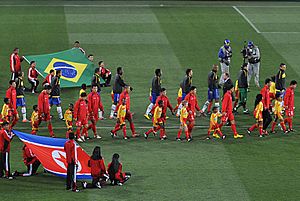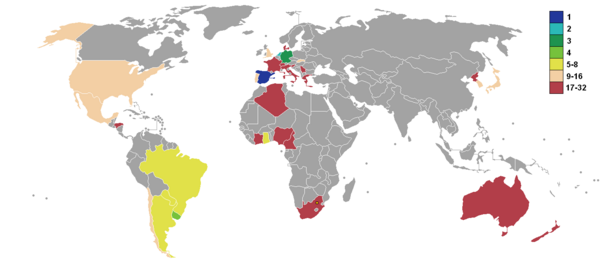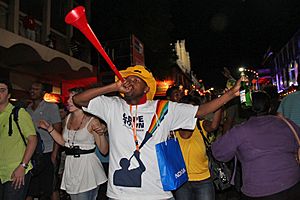2010 FIFA World Cup facts for kids
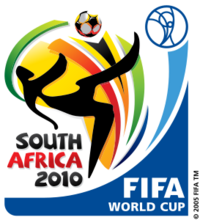
Ke nako (Setswana and Sesotho)
It's time. Celebrate Africa's Humanity (English) Dis tyd. Vier Afrika se mensdom (Afrikaans) Isikhathi. Gubha Ubuntu Base-Afrika (Zulu) Lixesha. Ukubhiyozela Ubuntu baseAfrika (Xhosa) Inguva. Kupemberera hupenyu hweAfrica (Shona) Ke nako. Keteka Botho ba Afrika (Southern Sotho) |
|
| Tournament details | |
|---|---|
| Host country | South Africa |
| Dates | 11 June – 11 July |
| Teams | 32 (from 6 confederations) |
| Venue(s) | 10 (in 9 host cities) |
| Final positions | |
| Champions | |
| Runners-up | |
| Third place | |
| Fourth place | |
| Tournament statistics | |
| Matches played | 64 |
| Goals scored | 145 (2.27 per match) |
| Attendance | 3,178,856 (49,670 per match) |
| Top scorer(s) | (5 goals each) |
| Best player | |
| Best young player | |
| Best goalkeeper | |
| Fair play award | |
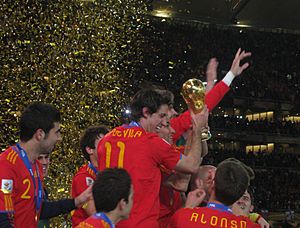
The 2010 FIFA World Cup was a huge international football (soccer) tournament. It was the 19th time this world championship for men's national teams was held. The event took place in South Africa from June 11 to July 11, 2010.
South Africa was chosen to host the tournament in 2004. This made it the first African nation to ever host the FIFA World Cup finals!
Thirty-two teams from around the world competed. They first played in groups, and the best teams moved on to the knockout stage. In the exciting final match, Spain beat the Netherlands 1–0 after extra time. This was Spain's first World Cup title! They also became the first European team to win the World Cup outside of Europe.
Interestingly, the host nation, South Africa, did not make it past the first round. Also, the two teams from the 2006 World Cup final, Italy and France, were also eliminated early. This was the first time the host country was knocked out in the group stage. New Zealand was the only team that didn't lose any games, but they also didn't advance past the group stage.
Host Cities and Stadiums
For the 2010 World Cup, matches were played in 10 stadiums across nine cities in South Africa. The opening game and the final match were both held at the Soccer City stadium in Johannesburg, South Africa's biggest city.
Some stadiums were at high altitudes, which could affect how the ball moved and how players performed. Six of the ten stadiums were over 1,200 meters (about 3,900 feet) above sea level. The two stadiums in Johannesburg, FNB Stadium (Soccer City) and Ellis Park Stadium, were the highest, at about 1,750 meters (about 5,700 feet).
The FNB Stadium, Cape Town Stadium, and Nelson Mandela Bay Stadium in Port Elizabeth hosted the most games, with eight matches each.
| Johannesburg | Cape Town | Durban | |
|---|---|---|---|
| FNB Stadium (Soccer City) |
Ellis Park Stadium | Cape Town Stadium (Green Point Stadium) |
Moses Mabhida Stadium (Durban Stadium) |
| 26°14′5.27″S 27°58′56.47″E / 26.2347972°S 27.9823528°E | 26°11′51.07″S 28°3′38.76″E / 26.1975194°S 28.0607667°E | 33°54′12.46″S 18°24′40.15″E / 33.9034611°S 18.4111528°E | 29°49′46″S 31°01′49″E / 29.82944°S 31.03028°E |
| Capacity: 84,490 | Capacity: 55,686 | Capacity: 64,100 | Capacity: 62,760 |
 |
 |
 |
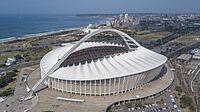 |
| Pretoria | |||
| Loftus Versfeld Stadium | |||
| 25°45′12″S 28°13′22″E / 25.75333°S 28.22278°E | |||
| Capacity: 42,858 | |||
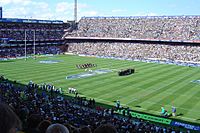 |
|||
| Port Elizabeth | Stadiums in Johannesburg | ||
| Nelson Mandela Bay Stadium | |||
| 33°56′16″S 25°35′56″E / 33.93778°S 25.59889°E | |||
| Capacity: 42,486 | |||
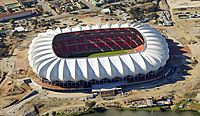 |
|||
| Rustenburg | Polokwane | Nelspruit | Bloemfontein |
| 25°34′43″S 27°09′39″E / 25.5786°S 27.1607°E | 23°55′29″S 29°28′08″E / 23.924689°S 29.468765°E | 25°27′42″S 30°55′47″E / 25.46172°S 30.929689°E | 29°07′02.25″S 26°12′31.85″E / 29.1172917°S 26.2088472°E |
| Royal Bafokeng Stadium | Peter Mokaba Stadium | Mbombela Stadium | Free State Stadium |
| Capacity: 42,000 | Capacity: 41,733 | Capacity: 40,929 | Capacity: 40,911 |
 |
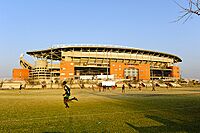 |
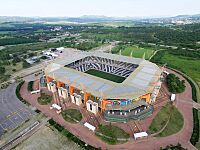 |
 |
Teams and Players
Each of the 32 teams had a squad of 23 players. Most of these players played for clubs in Europe, especially in England, Germany, Italy, Spain, and France.
A cool fact about the 2010 World Cup is that the Honduras team had three brothers on their squad: Jerry, Johnny, and Wilson Palacios. Also, in the game between Germany and Ghana, two brothers, Jérôme and Kevin-Prince Boateng, played against each other for different countries!
Match Results
The 32 national teams played a total of 64 matches. These games started with the group stage and then moved to the knockout stage. Teams were eliminated as the tournament went on. All times listed below are in South African Standard Time (UTC+02).
| Day | Time | Venue | Stage | Team 1 | Result | Team 2 | |
|---|---|---|---|---|---|---|---|
| Thursday 10 June |
Preliminary events | ||||||
| 20:00 | Soweto | FIFA Kick-off Celebration Concert | |||||
| Friday 11 June |
14:00 | Johannesburg (SC) | Opening ceremony | ||||
| First round of group stage matches | |||||||
| 16:00 | Johannesburg (SC) | Group A | South Africa |
1–1 | |||
| 20:30 | Cape Town | Uruguay |
0–0 | ||||
| Saturday 12 June |
13:30 | Port Elizabeth | Group B | South Korea |
2–0 | ||
| 16:00 | Johannesburg (EP) | Argentina |
1–0 | ||||
| 20:30 | Rustenburg | Group C | England |
1–1 | |||
| Sunday 13 June |
13:30 | Polokwane | Algeria |
0–1 | |||
| 16:00 | Pretoria | Group D | Serbia |
0–1 | |||
| 20:30 | Durban | Germany |
4–0 | ||||
| Monday 14 June |
13:30 | Johannesburg (SC) | Group E | Netherlands |
2–0 | ||
| 16:00 | Bloemfontein | Japan |
1–0 | ||||
| 20:30 | Cape Town | Group F | Italy |
1–1 | |||
| Tuesday 15 June |
13:30 | Rustenburg | New Zealand |
1–1 | |||
| 16:00 | Port Elizabeth | Group G | Ivory Coast |
0–0 | |||
| 20:30 | Johannesburg (EP) | Brazil |
2–1 | ||||
| Wednesday 16 June |
13:30 | Nelspruit | Group H | Honduras |
0–1 | ||
| 16:00 | Durban | Spain |
0–1 | ||||
| Second round of group stage matches | |||||||
| 20:30 | Pretoria | Group A | South Africa |
0–3 | |||
| Thursday 17 June |
13:30 | Johannesburg (SC) | Group B | Argentina |
4–1 | ||
| 16:00 | Bloemfontein | Greece |
2–1 | ||||
| 20:30 | Polokwane | Group A | France |
0–2 | |||
| Friday 18 June |
13:30 | Port Elizabeth | Group D | Germany |
0–1 | ||
| 16:00 | Johannesburg (EP) | Group C | Slovenia |
2–2 | |||
| 20:30 | Cape Town | England |
0–0 | ||||
| Saturday 19 June |
13:30 | Durban | Group E | Netherlands |
1–0 | ||
| 16:00 | Rustenburg | Group D | Ghana |
1–1 | |||
| 20:30 | Pretoria | Group E | Cameroon |
1–2 | |||
| Sunday 20 June |
13:30 | Bloemfontein | Group F | Slovakia |
0–2 | ||
| 16:00 | Nelspruit | Italy |
1–1 | ||||
| 20:30 | Johannesburg (SC) | Group G | Brazil |
3–1 | |||
| Monday 21 June |
13:30 | Cape Town | Portugal |
7–0 | |||
| 16:00 | Port Elizabeth | Group H | Chile |
1–0 | |||
| 20:30 | Johannesburg (EP) | Spain |
2–0 | ||||
| Tuesday 22 June |
Third round of group stage matches | ||||||
| 16:00 | Rustenburg | Group A | Mexico |
0–1 | |||
| Bloemfontein | France |
1–2 | |||||
| 20:30 | Durban | Group B | Nigeria |
2–2 | |||
| Polokwane | Greece |
0–2 | |||||
| Wednesday 23 June |
16:00 | Port Elizabeth | Group C | Slovenia |
0–1 | ||
| Pretoria | United States |
1–0 | |||||
| 20:30 | Johannesburg (SC) | Group D | Ghana |
0–1 | |||
| Nelspruit | Australia |
2–1 | |||||
| Thursday 24 June |
16:00 | Johannesburg (EP) | Group F | Slovakia |
3–2 | ||
| Polokwane | Paraguay |
0–0 | |||||
| 20:30 | Rustenburg | Group E | Denmark |
1–3 | |||
| Cape Town | Cameroon |
1–2 | |||||
| Friday 25 June |
16:00 | Durban | Group G | Portugal |
0–0 | ||
| Nelspruit | North Korea |
0–3 | |||||
| 20:30 | Pretoria | Group H | Chile |
1–2 | |||
| Bloemfontein | Switzerland |
0–0 | |||||
| Saturday 26 June |
Knockout stage matches | ||||||
| 16:00 | Port Elizabeth | Round of 16 | Uruguay |
2–1 | |||
| 20:30 | Rustenburg | United States |
1–2 (aet) | ||||
| Sunday 27 June |
16:00 | Bloemfontein | Germany |
4–1 | |||
| 20:30 | Johannesburg (SC) | Argentina |
3–1 | ||||
| Monday 28 June |
16:00 | Durban | Netherlands |
2–1 | |||
| 20:30 | Johannesburg (EP) | Brazil |
3–0 | ||||
| Tuesday 29 June |
16:00 | Pretoria | Paraguay |
0–0 (aet) (5–3 p) |
|||
| 20:30 | Cape Town | Spain |
1–0 | ||||
| Wednesday 30 June |
Rest days | ||||||
| Thursday 1 July |
|||||||
| Friday 2 July |
16:00 | Port Elizabeth | Quarter-finals | Netherlands |
2–1 | ||
| 20:30 | Johannesburg (SC) | Uruguay |
1–1 (aet) (4–2 p) |
||||
| Saturday 3 July |
16:00 | Cape Town | Argentina |
0–4 | |||
| 20:30 | Johannesburg (EP) | Paraguay |
0–1 | ||||
| Sunday 4 July |
Rest days | ||||||
| Monday 5 July |
|||||||
| Tuesday 6 July |
20:30 | Cape Town | Semi-finals | Uruguay |
2–3 | ||
| Wednesday 7 July |
Durban | Germany |
0–1 | ||||
| Thursday 8 July |
Rest days | ||||||
| Friday 9 July |
|||||||
| Saturday 10 July |
20:30 | Port Elizabeth | Third place match |
Uruguay |
2–3 | ||
| Sunday 11 July |
18:30 | Johannesburg (SC) | Closing ceremony | ||||
| 20:30 | Final | Netherlands |
0–1 (aet) | ||||
Tournament Statistics
Top Goal Scorers
Siphiwe Tshabalala from South Africa scored the very first goal of the tournament. He scored in the opening game, which was a 1–1 draw against Mexico.
Gonzalo Higuaín from Argentina was the only player to score three goals in one game (a hat-trick). This happened in Argentina's 4–1 win over South Korea.
Spain, the winning team, set a new record for scoring the fewest goals by a World Cup champion, with only eight goals. They also had the fewest goals conceded (only 2), meaning they let in very few goals. Spain was the first team to win the World Cup without letting in any goals during the knockout stage.
The top four goal scorers in the tournament each scored five goals. These players were Thomas Müller (Germany), Wesley Sneijder (Netherlands), David Villa (Spain), and Diego Forlán (Uruguay). Thomas Müller won the Golden Boot award because he also had three assists, which are passes that lead to a goal.
In total, 145 goals were scored in the 2010 World Cup. This was the lowest number of goals in any World Cup since the tournament started having 64 games.
5 goals
4 goals
 Gonzalo Higuaín
Gonzalo Higuaín Miroslav Klose
Miroslav Klose Róbert Vittek
Róbert Vittek
3 goals
2 goals
 Carlos Tevez
Carlos Tevez Brett Holman
Brett Holman Elano
Elano Robinho
Robinho Samuel Eto'o
Samuel Eto'o Lukas Podolski
Lukas Podolski Keisuke Honda
Keisuke Honda Javier Hernández
Javier Hernández Arjen Robben
Arjen Robben Kalu Uche
Kalu Uche Tiago
Tiago Lee Chung-yong
Lee Chung-yong Lee Jung-soo
Lee Jung-soo Andrés Iniesta
Andrés Iniesta
1 goal
 Martín Demichelis
Martín Demichelis Gabriel Heinze
Gabriel Heinze Martín Palermo
Martín Palermo Tim Cahill
Tim Cahill Juan
Juan Maicon
Maicon Jean Beausejour
Jean Beausejour Mark González
Mark González Rodrigo Millar
Rodrigo Millar Nicklas Bendtner
Nicklas Bendtner Dennis Rommedahl
Dennis Rommedahl Jon Dahl Tomasson
Jon Dahl Tomasson Jermain Defoe
Jermain Defoe Steven Gerrard
Steven Gerrard Matthew Upson
Matthew Upson Florent Malouda
Florent Malouda Cacau
Cacau Arne Friedrich
Arne Friedrich Marcell Jansen
Marcell Jansen Sami Khedira
Sami Khedira Mesut Özil
Mesut Özil Kevin-Prince Boateng
Kevin-Prince Boateng Sulley Muntari
Sulley Muntari Dimitris Salpingidis
Dimitris Salpingidis Vasilis Torosidis
Vasilis Torosidis Daniele De Rossi
Daniele De Rossi Antonio Di Natale
Antonio Di Natale Vincenzo Iaquinta
Vincenzo Iaquinta Fabio Quagliarella
Fabio Quagliarella Didier Drogba
Didier Drogba Salomon Kalou
Salomon Kalou Romaric
Romaric Yaya Touré
Yaya Touré Yasuhito Endō
Yasuhito Endō Shinji Okazaki
Shinji Okazaki Cuauhtémoc Blanco
Cuauhtémoc Blanco Rafael Márquez
Rafael Márquez Klaas-Jan Huntelaar
Klaas-Jan Huntelaar Dirk Kuyt
Dirk Kuyt Giovanni van Bronckhorst
Giovanni van Bronckhorst Robin van Persie
Robin van Persie Winston Reid
Winston Reid Shane Smeltz
Shane Smeltz Yakubu
Yakubu Ji Yun-nam
Ji Yun-nam Antolín Alcaraz
Antolín Alcaraz Cristian Riveros
Cristian Riveros Enrique Vera
Enrique Vera Hugo Almeida
Hugo Almeida Cristiano Ronaldo
Cristiano Ronaldo Liédson
Liédson Raul Meireles
Raul Meireles Simão
Simão Milan Jovanović
Milan Jovanović Marko Pantelić
Marko Pantelić Kamil Kopúnek
Kamil Kopúnek Valter Birsa
Valter Birsa Robert Koren
Robert Koren Zlatan Ljubijankić
Zlatan Ljubijankić Bongani Khumalo
Bongani Khumalo Katlego Mphela
Katlego Mphela Siphiwe Tshabalala
Siphiwe Tshabalala Park Chu-young
Park Chu-young Park Ji-sung
Park Ji-sung Carles Puyol
Carles Puyol Gelson Fernandes
Gelson Fernandes Michael Bradley
Michael Bradley Clint Dempsey
Clint Dempsey Edinson Cavani
Edinson Cavani Álvaro Pereira
Álvaro Pereira Maxi Pereira
Maxi Pereira
1 own goal
 Daniel Agger (against Netherlands)
Daniel Agger (against Netherlands) Park Chu-young (against Argentina)
Park Chu-young (against Argentina)
Final Team Rankings
After the tournament, FIFA created a final ranking for all 32 teams. This ranking was based on how far each team went in the competition, their overall results, and the strength of the teams they played against.
| R | Team | G | Pld | W | D | L | GF | GA | GD | Pts. |
|---|---|---|---|---|---|---|---|---|---|---|
| 1 | H | 7 | 6 | 0 | 1 | 8 | 2 | +6 | 18 | |
| 2 | E | 7 | 6 | 0 | 1 | 12 | 6 | +6 | 18 | |
| 3 | D | 7 | 5 | 0 | 2 | 16 | 5 | +11 | 15 | |
| 4 | A | 7 | 3 | 2 | 2 | 11 | 8 | +3 | 11 | |
| Eliminated in the quarter-finals | ||||||||||
| 5 | B | 5 | 4 | 0 | 1 | 10 | 6 | +4 | 12 | |
| 6 | G | 5 | 3 | 1 | 1 | 9 | 4 | +5 | 10 | |
| 7 | D | 5 | 2 | 2 | 1 | 5 | 4 | +1 | 8 | |
| 8 | F | 5 | 1 | 3 | 1 | 3 | 2 | +1 | 6 | |
| Eliminated in the round of 16 | ||||||||||
| 9 | E | 4 | 2 | 1 | 1 | 4 | 2 | +2 | 7 | |
| 10 | H | 4 | 2 | 0 | 2 | 3 | 5 | −2 | 6 | |
| 11 | G | 4 | 1 | 2 | 1 | 7 | 1 | +6 | 5 | |
| 12 | C | 4 | 1 | 2 | 1 | 5 | 5 | 0 | 5 | |
| 13 | C | 4 | 1 | 2 | 1 | 3 | 5 | −2 | 5 | |
| 14 | A | 4 | 1 | 1 | 2 | 4 | 5 | −1 | 4 | |
| 15 | B | 4 | 1 | 1 | 2 | 6 | 8 | −2 | 4 | |
| 16 | F | 4 | 1 | 1 | 2 | 5 | 7 | −2 | 4 | |
| Eliminated in the group stage | ||||||||||
| 17 | G | 3 | 1 | 1 | 1 | 4 | 3 | +1 | 4 | |
| 18 | C | 3 | 1 | 1 | 1 | 3 | 3 | 0 | 4 | |
| 19 | H | 3 | 1 | 1 | 1 | 1 | 1 | 0 | 4 | |
| 20 | A | 3 | 1 | 1 | 1 | 3 | 5 | −2 | 4 | |
| 21 | D | 3 | 1 | 1 | 1 | 3 | 6 | −3 | 4 | |
| 22 | F | 3 | 0 | 3 | 0 | 2 | 2 | 0 | 3 | |
| 23 | D | 3 | 1 | 0 | 2 | 2 | 3 | −1 | 3 | |
| 24 | E | 3 | 1 | 0 | 2 | 3 | 6 | −3 | 3 | |
| 25 | B | 3 | 1 | 0 | 2 | 2 | 5 | −3 | 3 | |
| 26 | F | 3 | 0 | 2 | 1 | 4 | 5 | −1 | 2 | |
| 27 | B | 3 | 0 | 1 | 2 | 3 | 5 | −2 | 1 | |
| 28 | C | 3 | 0 | 1 | 2 | 0 | 2 | −2 | 1 | |
| 29 | A | 3 | 0 | 1 | 2 | 1 | 4 | −3 | 1 | |
| 30 | H | 3 | 0 | 1 | 2 | 0 | 3 | −3 | 1 | |
| 31 | E | 3 | 0 | 0 | 3 | 2 | 5 | −3 | 0 | |
| 32 | G | 3 | 0 | 0 | 3 | 1 | 12 | −11 | 0 | |
Awards and Recognition
Main Awards
- Golden Ball: Diego Forlán (Uruguay) - This award goes to the best player of the tournament.
- Golden Boot: Thomas Müller (Germany) - For the top goal scorer.
- Golden Glove: Iker Casillas (Spain) - For the best goalkeeper.
- Best Young Player: Thomas Müller (Germany) - For the best player under 21.
- FIFA Fair Play Trophy: Spain - For the team with the best sportsmanship.
All-Star Team
FIFA also announced an All-Star Team based on player performance.
| Goalkeeper | Defenders | Midfielders | Forwards |
|---|---|---|---|
|
|
Fan-Voted Dream Team
For the first time, fans could vote online for their own "Dream Team" of the tournament. Six players and the coach from the winning Spanish team were chosen by the public.
| Goalkeeper | Defenders | Midfielders | Forwards |
|---|---|---|---|
|
|
World Cup Fun Facts
Official Symbols
- Mascot: The official mascot was Zakumi, a friendly African leopard with green hair. His name combines "ZA" (for South Africa) and "kumi," meaning "ten" in several African languages, referring to the year 2010.
- Match Ball: The official match ball was called the Jabulani, which means "bringing joy to everyone" in the Zulu language. It had 11 colors, representing the 11 players on a team and the 11 official languages of South Africa. A special gold ball, the Jo'bulani, was used for the final game. Some players found the new ball tricky to control!
- Music: The official song was "Waka Waka (This Time for Africa)", performed by Colombian singer Shakira and the South African band Freshlyground. It was sung in English and Spanish and became very popular.
The Vuvuzela Sound
The 2010 World Cup made the vuvuzela famous around the world. This long horn was blown by fans throughout the matches, creating a very loud, buzzing sound.
Many players and commentators complained about the noise. Some players said it made it hard to talk to their teammates on the field. TV viewers also noticed that the vuvuzela sound often drowned out other stadium noises. Broadcasting companies even looked into ways to reduce the vuvuzela sound for TV audiences.
Media Coverage
Watching the Games
The 2010 FIFA World Cup was expected to be one of the most-watched TV events ever! Hundreds of TV channels broadcast the games to billions of people worldwide. FIFA estimated that about 700 million viewers watched the World Cup final match.
New digital ways to watch also became popular. Many people watched games live on their phones and computers, making it the most online-covered sports event at the time.
Filming Technology
Sony technology was used to film the tournament. For the first time, 25 matches were filmed using 3D cameras, offering a new way to experience the game.
Video Games
Fans could also play the official 2010 World Cup video game released by EA Sports. There was even a virtual stadium in PlayStation Home where fans could gather.
Fan Festivals
FIFA also set up "Fan Fests" in major cities around the world, like Sydney, Berlin, and Rio de Janeiro. These were special areas where fans could gather to watch the games on big screens and celebrate together. The Fan Fests in Durban and Cape Town were very popular in South Africa.
Images for kids
See also
 In Spanish: Copa Mundial de Fútbol de 2010 para niños
In Spanish: Copa Mundial de Fútbol de 2010 para niños


